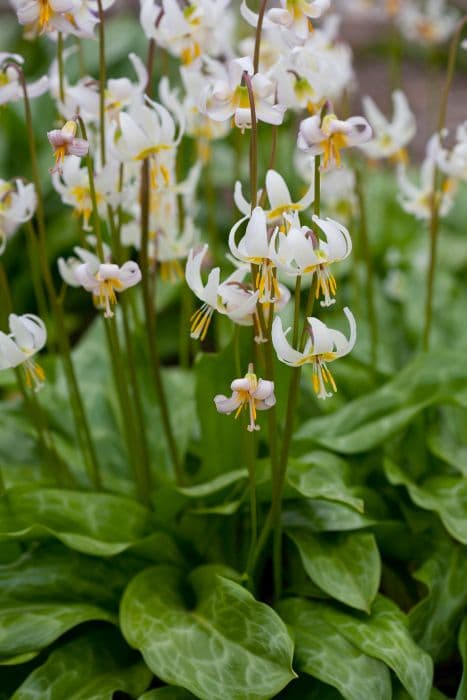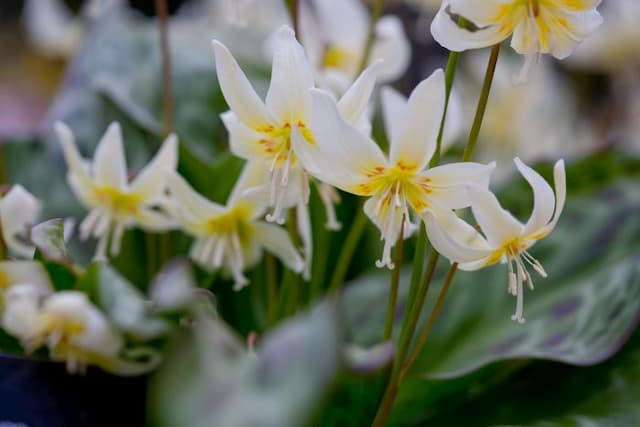Yellow Toad Lily Tricyrtis flava

ABOUT
Tricyrtis flava, commonly known as the yellow toad lily, is an ornamental plant known for its distinctive and attractive flowers. The plant produces arching stems and lush green foliage, with leaves arranged alternately along the stems. The leaves are often lance-shaped or somewhat oval, with a texture that may be seen as somewhat rough, adding to its visual interest. The most striking feature of the yellow toad lily is its unique flowers. These blooms are generally yellow, a color that can range from pale to a deep, golden hue. Each flower is intricately spotted or speckled, providing a beautiful contrast against the yellow background. The blossoms are star-shaped and typically have six petals, each petal often elegantly recurved, giving the flowers a delicate, almost orchid-like appearance. Inside the flower, observers may notice a set of prominent anthers that contribute to the visual complexity and attractiveness of the bloom. These flowers are usually borne in clusters at the end of the stems or in the leaf axils, appearing in the late summer to fall, which makes them valuable for gardeners looking to extend the blooming season in their garden displays. The yellow toad lily is admired not only for its aesthetic appeal but also for its ability to thrive in shadier conditions, where many other flowering plants might not perform as well. It often brings a pop of late-season color to woodland gardens, shady borders, or other garden areas that enjoy partial to full shade. While less common than its purple-flowered relatives in the toad lily family, the yellow toad lily nevertheless shares the family's characteristic charm and unique beauty, making it an attractive choice for garden enthusiasts seeking something a little different for their shade gardens.
About this plant
 Names
NamesFamily
Liliaceae.
Synonyms
Yellow Toad Lily.
Common names
Tricyrtis flava.
 Toxicity
ToxicityTo humans
Tricyrtis flava, commonly known as yellow toad lily, is not typically listed as a poisonous plant to humans. Generally, members of the Tricyrtis genus are not known for being toxic. However, as with many plants, individual sensitivities can vary. If a person has sensitive skin or allergies, they may experience irritation when handling this or similar plants. Ingesting parts of the plant is not advisable as it might cause mild stomach upset. It is important to consult with medical professionals for advice specific to individual health concerns or in the case of accidental ingestion.
To pets
The yellow toad lily is not widely recognised as a toxic plant for pets either, including cats and dogs. There is limited information on severe toxicity in pets resulting from ingestion of this plant. However, as with humans, pets can have varying sensitivities to different plants, and ingesting any non-food plant can potentially lead to gastrointestinal upset such as vomiting or diarrhea. It is always best to keep an eye on pets and prevent them from eating plants to avoid any potential issues. If a pet does consume any part of the yellow toad lily and shows signs of distress, it is recommended to contact a veterinarian.
 Characteristics
CharacteristicsLife cycle
Perennials
Foliage type
Deciduous
Color of leaves
Green
Flower color
Yellow
Height
2 feet (0.61 meters)
Spread
2 feet (0.61 meters)
Plant type
Herb
Hardiness zones
5
Native area
Asia
Benefits
 General Benefits
General Benefits- Ornamental Appeal: Tricyrtis flava, commonly known as Yellow Toad Lily, offers unique ornamental value to gardens with its striking yellow flowers and speckled petals.
- Shade Tolerance: This plant is well-adapted to shade, making it ideal for planting under trees or in other shaded areas where many flowering plants struggle.
- Late Season Blooms: Yellow Toad Lilies bloom in late summer to fall, providing vibrant color and interest during a time when many other plants have finished flowering.
- Wildlife Attraction: The blooms of Tricyrtis flava attract pollinators like bees and butterflies, supporting local ecosystems and increasing biodiversity in the garden.
- Low Maintenance: This plant is relatively low maintenance, requiring minimal care once established, making it suitable for busy gardeners or those looking for lower-effort landscaping options.
- Resistance to Pests: It is generally resistant to pests and diseases, which can help reduce the need for chemical treatments in the garden.
- Easy Propagation: Yellow Toad Lily can be easily propagated by division, allowing gardeners to expand their plantings and share with others.
 Medical Properties
Medical PropertiesThis plant is not used for medical purposes.
 Air-purifying Qualities
Air-purifying QualitiesThis plant is not specifically known for air purifying qualities.
 Other Uses
Other Uses- Tricyrtis flava, commonly known as yellow toad lily, can be used as a natural textile dye, providing unique hues to fabrics due to its pigmentation.
- The mucilaginous texture of the yellow toad lily's leaves might be experimented with as a natural thickener in culinary recipes, similar to okra or aloe vera.
- With its distinctive spotted flowers, yellow toad lily can be a muse for artists and designers seeking inspiration for patterns and motifs in their work.
- The sap from yellow toad lily stems has been traditionally used in some cultures for a temporary adhesive in small crafts or to mend torn paper material y.
- The crushed leaves of the yellow toad lily can potentially be used as a natural insect repellent due to their unique chemical composition.
- Enthusiasts of natural inks might find the juice extracted from yellow toad lily flowers useful in creating botanical inks for art or writing purposes.
- Yellow toad lily’s sturdy stems can be woven into small baskets or decorative items by skilled crafters, making use of its fibrous quality.
- When dried, different parts of yellow toad lily could serve as components in potpourri mixes, contributing a woodsy scent and texture to the blend.
- Yellow toad lily seed pods can be used in jewelry making, either as natural beads or as inspiration for metal or ceramic replicas.
- The plant can be a teaching tool in horticultural classes or workshops, showcasing the propagation and cultivation techniques unique to the yellow toad lily.
Interesting Facts
 Feng Shui
Feng ShuiThe Toad Lily is not used in Feng Shui practice.
 Zodiac Sign Compitability
Zodiac Sign CompitabilityThe Toad Lily is not used in astrology practice.
 Plant Symbolism
Plant Symbolism- Unique Beauty: With its exotic, orchid-like blooms, Tricyrtis flava, commonly known as Yellow Toad Lily, symbolizes a beauty that is uncommon and not immediately obvious, inviting onlookers to pay closer attention.
- Overcoming Obstacles: As a plant that thrives in conditions others may find challenging, such as shade, it represents the ability to overcome adversity and flourish in unexpected places.
- Mystery and Fascination: The speckled and intricate flowers of the Yellow Toad Lily can symbolize the mysteries and fascinations of life, echoing the complexity and depth found in the natural world.
- Appreciation of the Unique: This plant can be a symbol for the appreciation of diversity and the unique traits in individuals, celebrating differences rather than commonality.
 Water
WaterToad lily, or Tricyrtis flava, prefers consistently moist soil, so watering should be done regularly to maintain soil moisture without causing waterlogging. Aim to water the plant with approximately one inch of water weekly, but adjust the amount depending on climate conditions and soil drainage. During the peak of summer or in dryer conditions, increase watering frequency to prevent the soil from drying out. Conversely, in cooler or overcast periods, reduce the amount of water to prevent root rot. Always water at the base of the plant to avoid wetting the leaves, which can lead to fungal diseases.
 Light
LightToad lilies thrive in light conditions that provide protection from the harsh afternoon sun. They prefer part shade to full shade environments that offer bright, indirect sunlight. The ideal spot for a toad lily would be under the canopy of trees or on the north side of a building, where they can receive the filtered morning light and be sheltered during the intense midday heat.
 Temperature
TemperatureToad lilies are hardy and can tolerate a range of temperatures, but they perform best when the temperature stays between 50 and 75 degrees Fahrenheit. They can survive short periods of colder weather, down to about 40 degrees, but frost can damage the foliage and flowers. During hot spells, if temperatures consistently exceed 80 degrees Fahrenheit, providing some extra shade can help keep the plant cool.
 Pruning
PruningPruning toad lily plants is beneficial for removing dead or damaged foliage, which promotes healthy growth and improves the plant's overall appearance. Prune in early spring to remove winter-damaged leaves and in the aftermath of flowering to trim back spent flowers and encourage further blooming. Deadheading, or the removal of faded blooms, can also be performed periodically throughout the blooming season to maintain a tidy appearance.
 Cleaning
CleaningAs needed
 Soil
SoilYellow toad lily prefers well-draining, humus-rich soil with a pH ranging from 5.5 to 7. The ideal soil mix can be created with equal parts loam, peat, and perlite or sand to ensure proper drainage and moisture retention.
 Repotting
RepottingYellow toad lilies typically require repotting every two to three years. They should be repotted in the spring just before new growth starts to allow the plant to acclimate to its new container.
 Humidity & Misting
Humidity & MistingYellow toad lily thrives in moderate to high humidity levels. It is best to maintain humidity around 50-60% for optimal growth and health.
 Suitable locations
Suitable locationsIndoor
Place in bright, indirect light with high humidity.
Outdoor
Plant in partial shade; ensure soil stays moist.
Hardiness zone
4-9 USDA
 Life cycle
Life cycleTricyrtis flava, commonly known as yellow toad lily, typically begins its life cycle from seed, which germinates in spring to produce small, inconspicuous seedlings. The seedlings develop into fully grown plants with upright stems and alternate, lance-shaped leaves during the growing season. By mid to late summer, the plant reaches maturity and produces its distinctive yellow, spotted flowers often resembling orchids, which are capable of attracting pollinators to aid in reproduction. After pollination, the flowers develop into capsules which contain numerous tiny seeds. As autumn arrives, the plant prepares for dormancy, with above-ground parts dying back after frost and the underground rhizomes surviving through winter. In the following spring, the cycle recommences, with new growth emerging from the rhizomes to start the process anew.
 Propogation
PropogationPropogation time
Spring-Early Summer
Tricyrtis flava, commonly known as the yellow toad lily, is often propagated by dividing its rhizomes. The best time for this is in the spring, just as the plants begin to emerge and the soil can be worked. To propagate, carefully dig up the clumps with a shovel, making sure to include as much of the root system as possible. Gently tease apart the rhizomes by hand or cut them with a sharp knife, ensuring that each division has at least two or three growth points or buds. Replant the divisions immediately at the same soil depth they were previously grown at, spacing them about a foot (12 inches or approximately 30 cm) apart to allow room for growth. Water the transplants well to help establish them. This method allows for a fairly reliable and straightforward way to increase your stock of yellow toad lilies.









